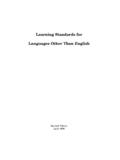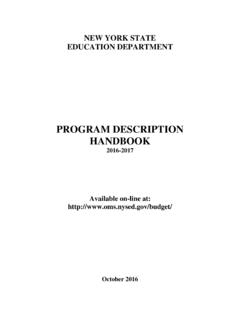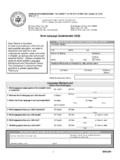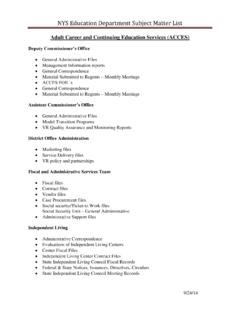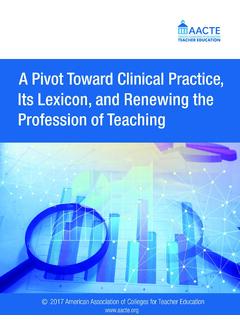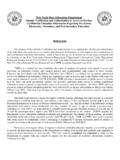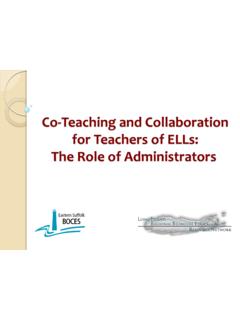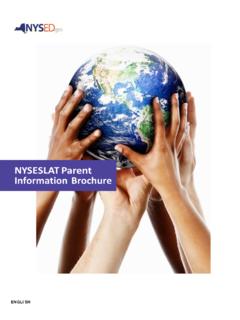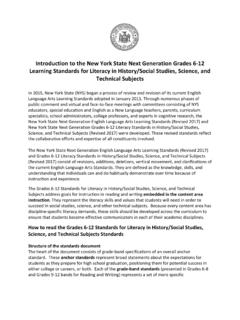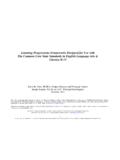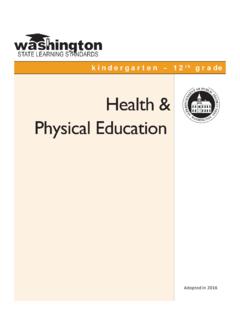Transcription of New York State Next Generation Learning Standards for ...
1 NEW YORK State . EDUCATION DEPARTMENT. New York State Next Generation GRADES Learning Standards for literacy in 6-12 History/Social Studies, Science and Technical Subjects New York State Education Department ENGLISH LANGUAGE ARTS Learning Standards 1. NEW YORK State . EDUCATION DEPARTMENT. Introduction to the New York State Next Generation Grades 6-12. Learning Standards for literacy in History/Social Studies, Science, and Technical Subjects In 2015, New York State (NYS) began a process of review and revision of its current English Language Arts Learning Standards adopted in January 2011.
2 Through numerous phases of public comment and virtual and face-to-face meetings with committees consisting of NYS educators, special education and English as a New Language teachers, parents, curriculum specialists, school administrators, college professors, and experts in cognitive research, the New York State Next Generation English Language Arts Learning Standards (Revised 2017) and New York State Next Generation Grades 6-12 literacy Standards in History/Social Studies, Science, and Technical Subjects (Revised 2017) were developed. These revised Standards reflect the collaborative efforts and expertise of all constituents involved.
3 The New York State Next Generation English Language Arts Learning Standards (Revised 2017) and Grades 6-12 literacy Standards in History/Social Studies, Science, and Technical Subjects (Revised 2017) consist of revisions, additions, deletions, vertical movement, and clarifications of the current English Language Arts Standards . They are defined as the knowledge, skills, and understanding that individuals can and do habitually demonstrate over time because of instruction and experience. The Grades 6-12 Standards for literacy in History/Social Studies, Science, and Technical Subjects address goals for instruction in reading and writing embedded in the content area instruction.
4 They represent the literacy skills and values that students will need in order to succeed in social studies, science, and other technical subjects. Because every content area has discipline-specific literacy demands, these skills should be developed across the curriculum to ensure that students become effective communicators in each of their academic disciplines. How to read the Grades 6-12 Standards for literacy in History/Social Studies, Science, and Technical Subjects Standards STRUCTURE OF THE Standards DOCUMENT. The heart of the document consists of grade-band specifications of an overall anchor standard.
5 These anchor Standards represent broad statements about the expectations for students as they prepare for high school graduation, positioning them for potential success in either college or careers, or both. Each of the grade-band Standards (presented in Grades 6-8 and Grades 9-12 bands for Reading and Writing) represents a set of more specific expectations. For each anchor standard, a detailed sweep of expectations rises from sixth grade to the graduation-ready level of twelfth graders. Learning Standards define what a student should know and be able to do.
6 Anchor Standards represent broad statements about the expectations for students as they prepare for high school graduation, positioning them for college and careers. The Anchor Standards included in literacy 6-12. are related to the ELA Anchor Standards , but include some slight differences to ensure alignment with the content areas. New York State Education Department Learning Standards FOR literacy IN HISTORY/SOCIAL STUDIES, SCIENCE AND 2. TECHNICAL SUBJECTS. NEW YORK State . EDUCATION DEPARTMENT. Grade-level and Grade-band Standards describe more specific end-of-year expectations about what students should understand and be able to do at a specific grade level or grade band.
7 Strands define the main organizational categories for English Language Arts and literacy (Reading, Writing, Speaking and Listening, and Language). Range, Quality, and Complexity of Student Reading sections clarify the reading and text complexity expectations for each grade level. This is located at the beginning of the Reading Standards at each grade level or grade band. EXAMPLE. New York State Education Department Learning Standards FOR literacy IN HISTORY/SOCIAL STUDIES, SCIENCE AND 3. TECHNICAL SUBJECTS. NEW YORK State . EDUCATION DEPARTMENT.
8 Key Points for Grades 6-12 literacy in History/Social Studies, Science, and Technical Subjects Standards Shared Responsibility for literacy Development Although literacy development certainly resides in the domain of the English Language Arts classroom, teachers in other disciplines have recognized the importance of literacy to their own subject areas. Concurrent with the recent revision of the English Language Arts Standards was the revision of the Standards for Grades 6-12 literacy in History/Social Studies, Science, and Technical Subjects.
9 The intent is for these two sets of Standards to work together. In this way, teachers from across the curriculum can plan their individual lessons knowing that they have common expectations for their students' literacy , as they pursue success in each of the content areas. This common goal shows up even more fundamentally at the elementary level, where a typical instructional model includes a teacher who provides instruction in a variety of subjects, including ELA. Although the literacy Standards share similar goals with the ELA Standards , they also recognized that each subject area has its own discourse practices and nomenclature.
10 The literacy Anchor Standards , while closely related, are somewhat different from the ELA. Anchor Standards . These differences are intentional. It is important to recognize that each subject area has its own special literacy demands. By design, these Standards avoid the one-size-fits-all message that identical Standards would imply. What is literacy ? A high degree of proficiency in literacy is essential as students attempt to acquire and build knowledge in each of the content areas. Students must be able to read social studies textbooks, analyze historical documents, follow scientific procedures, and discuss complex written problems, as well as respond to issues in their subject area content through speaking, writing, and crafting digital responses.

